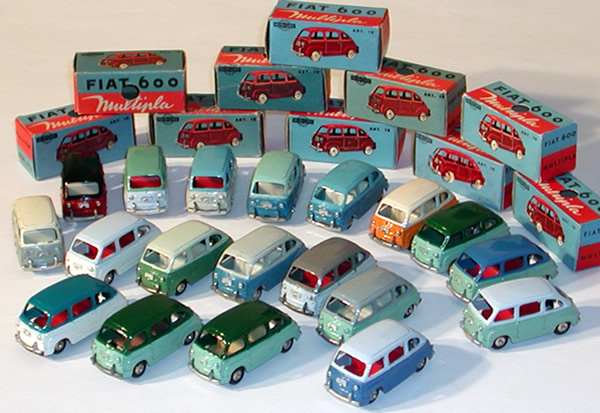|
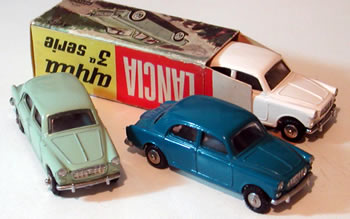
I was only one year when the Mercury began producing cars in
the original scale 1:48. In fact, in 1953 the Turin-based company,
already present in the market for several years, began producing
the FIAT 1100/103, with the round-shaped trunk. What a beautiful
103, with bench-shaped front seat and gear-shift at the steering
wheel. It reminds me of the many trips taken in the summer to
go on holiday to my grandmother's house, in Isili, a village
at the heart of Sardinia. We did not own the 103 (the first
car in my house, a grey Skoda Octavia, arrived in 1963), but
we used to take advantage of the courtesy of a wealthy neighbor
who for business reasons traveled to Cagliari on a regular basis.
Officially it was a six-seater, but we children traveled on
the lap of adults and the 103 fitted as many as 8-9 people at
a time and a lot of luggage on the roof. On narrow and bumpy
roads, screeching at every turn. Upon arrival I was happy to
see my grandmother, but my eyes followed the black 1100 that
went away grumbling. Good times.
Many other cars of my childhood have been reproduced by Mercury
in this scale. Some relatives had the Fiat 600 of the first
type, an aunt had a dark gray 1300 (what a luxury!), some family
friends had a Lancia Appia first series (as well as a Topolino
Belvedere with sunroof) and a neighbor owned a light gray Appia
third series. And again other friends had the red Beetle, with
reinforced bumpers in American style, others had a 500 with
suicide doors. In this neighborhood, you could always see a
dark blue Innocenti 950S, that was so low that it wasn't very
difficult for me to see the interior and its rich instrumentation,
and a red Giulietta Sprint, a spectacular car, whose owner did
not even want us kids to get near it. I wonder if he had had
as many as you can see here below ...
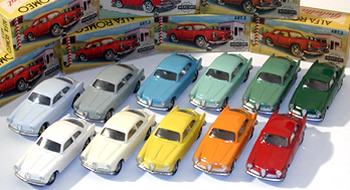
These Mercury models are very beautiful,
much more beautiful now, half a century later than at their
time. And, above all, painted in different colors, as if the
company had had a premonition of the demand of the future collectors
for those who were in reality just toys. Note, in fact, that
with a few hundred lire (the price of a score of daily newspapers)
you could buy a brand new Cadillac with its box. Today the same
model, if you find it, is sold at the equivalent of 150-200
daily newspapers. A substantial appreciation. Of course, if
you consider the color of the bodywork, of the seats and of
the roof covers, the rear badges (gold or silver) and of tires,
the variations are so many that the poor collector (in the sense
that his commitment is heavy) easily becomes poor (in the sense
that he needs a fortune to buy them all). But it is great to
see them all together.
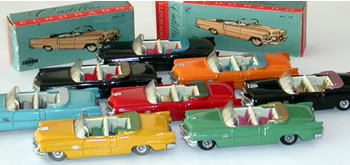
The simple Fiat 600 Multipla, two-tone,
and in good condition with the original box can easily exceed
100 euro, while originally was bought with about 500 lire. It
is this same model, always made in a two-tone livery, that holds
the record of color variations. In the big picture, on the top
of this page, you can count 19 pieces, all different. Looking
at the picture you could think of a duplication: the light green
model with a dark green roof seems to be repeated three times.
But the careful observer will note that the two models in the
foreground have the interiors of different color and the one
in the third row belongs to the very first series, with gray
wheels and without seats. You can get crazy! And these models
are mostly without windows, without suspension, without rhinestone
headlights, no decals, no interior... There is only the shell
of zamak (what is more, it is poorly finished and smudged),
the base and the wheels. Is it possible to have, apart from
the vernice of different colors, many other variations? The
answer is yes!
To help my fellow collectors to view the various series in chronological
order, I reported on the right side some useful tips about dating
and classification, without claiming to have offered a comprehensive
discussion, which remains open to contributions from everyone.
Thanks dear friends, for visiting this
page.
|
GENERAL
CLASSIFICATION
CRITERIA
The
models in this series have very similar characteristics (apart
from the scale, which often falls outside the declared 1:48)
and they have evolved, over time, depending on taste, competition
and technological developments. In general, the first version
does not have glass and interiors. It has not suspension and
the axles of the wheels are held in place by two narrow transversal
plaques, one at the front axle and one at the back. The base
(without any mechanical parts in relief) is painted silver
and riveted to the bodywork. The transversal plaques can be
painted or not. The bumpers are fused together to the base
or to the bodywork and to the front grille. The headlights
are made of back metal, with a tack. The rear lights are painted
red or orange. The plate is painted as the bodywork. Below,
you can see the base of a 1100/103 of the first series, with
the transversal plaques, and that of a Giulietta Sprint with
unpainted plaques.
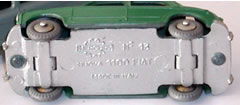
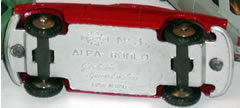
Later models are fitted with windows
and interiors. In some cases, we only find the interior (600
Multipla) and in other models just the windows. The lights
have been printed in the fusion of the bodywork. The base,
of the same kind as the first series, is now chromed instead
of just painted. See below the chrome plated base of a Studebaker
Golden Hawk.
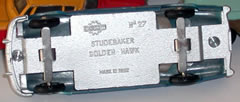
Some models did not have suspensions
for some time, but their bases were painted black, remaining
unchanged for the rest. However, many models, have been fitted
with suspensions and this fact has led Mercury to design new
bases. The new bases are first chrome plated and then painted
in matt black. See below, the base of a Flaminia (black, without
suspension), and the base of two Giulietta TI, first chrome
plated and then black, with suspension and no plaques.
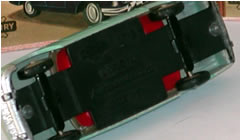
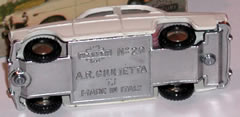
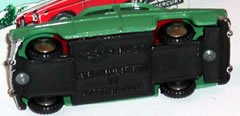
On some models begin to also have some embossed mechanical
parts, as you can see below in a Fiat 1300 with a smooth base,
which precedes the Fiat 1300 with embossed mechanical parts.
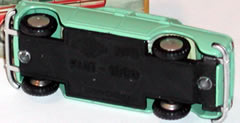
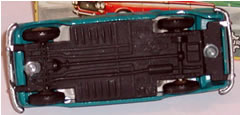
Unlike other brands such as Dinky Toys or Politoys Plast,
the color of the tires says very little about the chronological
development of the models. In fact, many models have always
been produced with black tires, while others were produced
mostly with gray tires. When a model had both types of tires,
generally, the gray tires preceded the blacks ones, but ...
tires are not riveted, and can easily be replaced.
In the specifications of the individual models will be found
more precise cataloging elements.
|
